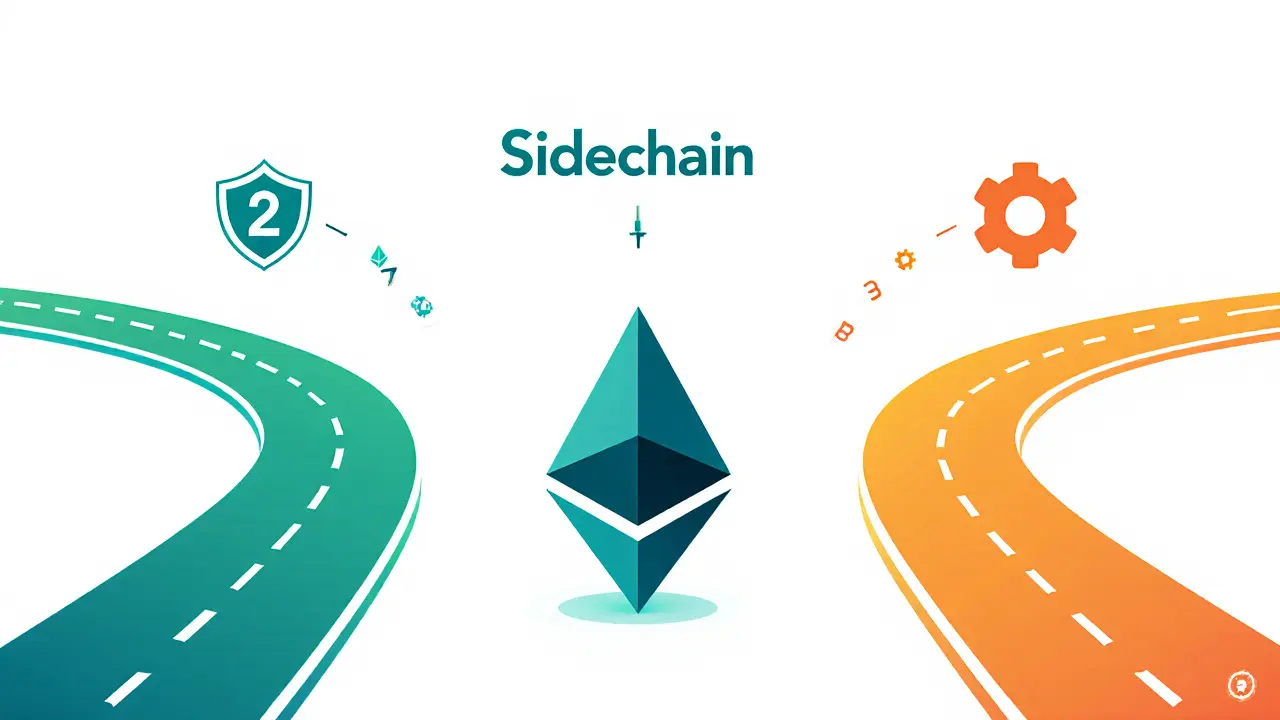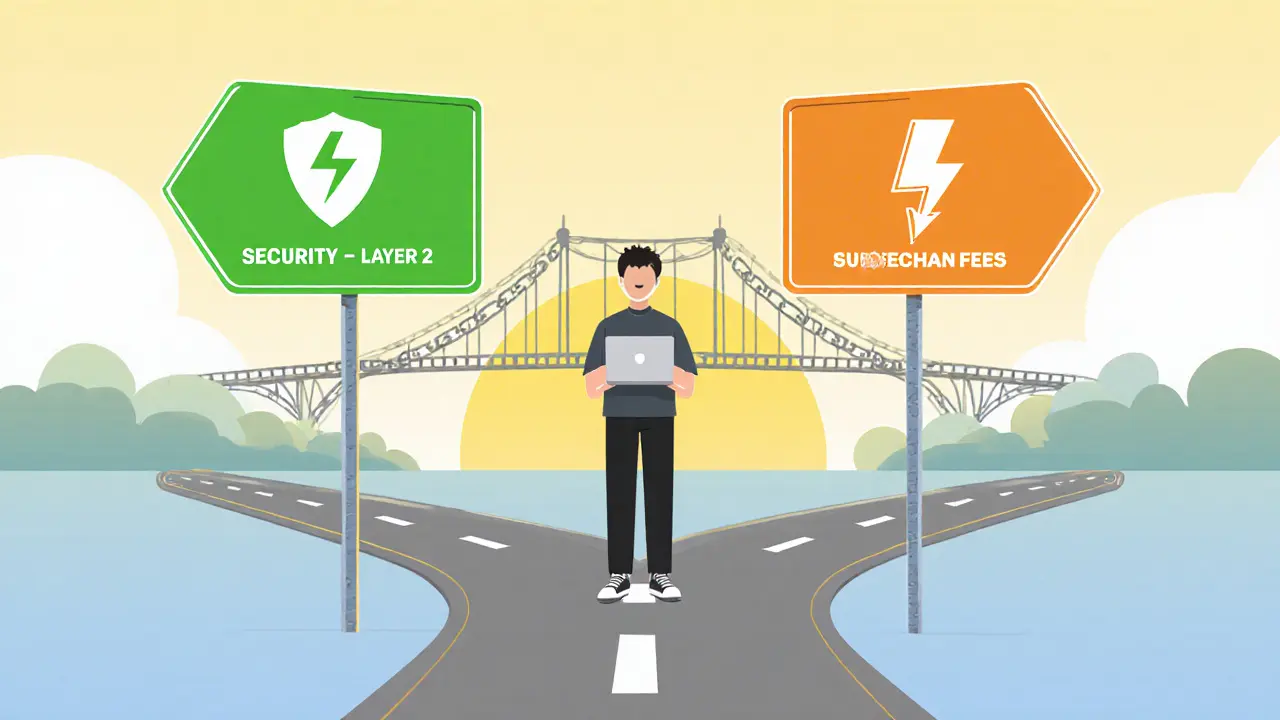Sidechains vs Layer 2: Complete Ethereum Scaling Comparison
 Dec, 15 2024
Dec, 15 2024
Key Takeaways
- Layer 2 solutions inherit Ethereum’s security, while sidechains trade some security for flexibility and lower fees.
- Sidechains such as Polygon PoS process far more transactions per second, but rely on their own validator set.
- Optimistic rollups need a challenge period (up to 7 days) for finality; ZK‑rollups settle instantly.
- Bridging assets between chains remains the biggest user‑experience friction point.
- Enterprise adoption skews heavily toward Layer 2, whereas gaming projects favor sidechains.
When you hear the buzz about scaling Ethereum, two words dominate the conversation: Sidechains are independent blockchains that run parallel to Ethereum, connected by a two‑way peg that lets assets move back and forth. They use their own consensus and can tweak fee structures, block times, or even virtual machine rules. On the other side, Layer 2 solutions are protocols that sit on top of the Ethereum mainnet, batch transactions off‑chain, and post a proof or summary to the base layer. Because they still rely on Ethereum’s security guarantees, they are often described as the “safe” way to scale.
Architectural Foundations
Both approaches aim to boost throughput, but they do it in fundamentally different ways.
Layer 2 can be split into three main families:
- Optimistic Rollups - e.g., Optimism and Arbitrum. Transactions are assumed valid and only challenged if someone submits a fraud proof within a 7‑day window.
- ZK‑Rollups - e.g., zkSync and StarkNet. A zero‑knowledge proof is generated for each batch, giving immediate finality.
- State Channels - like the Raiden Network, which lock funds in a multi‑signature contract and settle off‑chain.
All three keep data availability on Ethereum, posting calldata that costs roughly 16 k‑20 k gas per batch.
Sidechains have their own consensus. Polygon PoS, for instance, runs a Proof‑of‑Stake system with about 100 validators, while Gnosis Chain (formerly xDai) uses a similar PoS model but with a different fee token. Because the transaction data never touches Ethereum, fees look more like 2 k‑5 k gas‑equivalent, and finality can be as fast as 2‑3 seconds.
Security Trade‑offs
Security is the elephant in the room. Layer 2 solutions inherit the economic security of the Ethereum mainnet - that’s $40 billion+ of value protecting the rollups, according to L2BEAT (Sept 2024). A breach on the main chain would cascade to the rollups, but that’s an extremely unlikely scenario.
Sidechains, by contrast, protect only the value locked on their own networks - roughly $5‑7 billion total. If a validator set is compromised, the sidechain can be drained, as seen in the $600 million Harmony bridge hack (June 2022). The downside is that developers gain flexibility: they can tweak gas schedules, add custom pre‑compiles, or experiment with novel consensus without waiting for an Ethereum core upgrade.
Performance Metrics
Speed and cost matter to users. Recent data (Q3 2024) shows:
| Metric | Optimism (Optimistic Rollup) | Arbitrum (Optimistic Rollup) | Polygon PoS (Sidechain) | Gnosis Chain (Sidechain) |
|---|---|---|---|---|
| Weekly Tx Volume | ≈ 5 M | ≈ 6 M | ≈ 35 M | ≈ 8 M |
| TPS (peak) | 2 000‑3 000 | 2 500‑3 500 | 5 000‑10 000 | 4 000‑6 000 |
| Avg. Fee (USD) | ≈ $0.15 | ≈ $0.12 | ≈ $0.008 | ≈ $0.01 |
| Finality | ≈ 1 hour (post‑challenge) | 10‑15 min | 2‑3 sec | ≈ 5 sec |
The numbers illustrate why gaming dApps gravitate to sidechains, while DeFi stays on Layer 2 for the security guarantee.
Developer Experience
From a coder’s perspective, Layer 2 feels like a minor extension of Ethereum. Most smart contracts need less than a 5 % code change to compile on Optimism or Arbitrum, and the tooling (Hardhat, Foundry) already supports these networks out of the box. A 2024 ConsenSys guide notes a typical onboarding time of two to three weeks.
Sidechains demand a bit more work. Polygon PoS runs a slightly modified EVM; you have to configure the RPC endpoint, handle a different gas model, and sometimes adapt to custom pre‑compiles. Surveys from Chainstack (2024) report an average implementation window of four to six weeks. Documentation quality also varies - Layer 2 projects average 95 % completeness scores, while sidechains sit around 82 %.
Economic Considerations
Cost reduction is the headline. Layer 2 solutions cut Ethereum gas by 5‑50×, bringing a typical transaction down to $0.05‑$0.50. Sidechains go further, offering 100‑200× reductions, so a swap can cost as little as half a cent.
However, the lower fees come with higher capital risk. If a sidechain’s bridge is compromised, users can lose the bridged assets. Bridge hacks accounted for 65 % of total losses across scaling solutions in a 2024 Trail of Bits security report. In contrast, Layer 2 bridges have seen fewer high‑value incidents, though the Optimism withdrawal delay (up to 7 days) still frustrates users.
Use‑Case Landscape
Enterprises and high‑value DeFi platforms prefer Layer 2. Gartner’s 2024 blockchain adoption report shows 78 % of Fortune 500 blockchain projects run on a Layer 2, mainly for the security guarantees that regulators are comfortable with.
Gaming, NFTs, and social dApps lean toward sidechains. DappRadar’s 2024 sector analysis found sidechains hold 68 % of the gaming market share, thanks to their high TPS and near‑zero fees, which are critical for micro‑transactions.

Future Outlook
Ethereum’s upcoming Proto‑Danksharding (EIP‑4844) will slash Layer 2 calldata costs by up to 90 %, narrowing the fee gap with sidechains. At the same time, sidechains are racing to improve security - Polygon’s AggLayer initiative (2024) aims to create a shared liquidity hub that reduces reliance on single‑bridge trust assumptions.
Analysts differ on long‑term share. ConsenSys predicts Layer 2 will capture 90 % of Ethereum scaling by 2027, while Binance Research expects sidechains to retain a solid 25‑30 % slice for niche use cases.
In practice, the ecosystem is converging toward a multi‑layered model: Layer 2 provides the “security‑critical” scaling layer, and sidechains act as experimental sandboxes that can later feed innovations back to the main chain.
Decision Guide - Which Path to Choose?
Ask yourself these three questions before committing:
- Is security the top priority? If yes, stick with a Layer 2 rollup.
- Do you need ultra‑low fees and sub‑second finality for high‑volume micro‑transactions? Sidechains win here.
- Can your team handle bridge latency and potential regulatory nuance? Layer 2 bridges may take days, while sidechain bridges often require separate compliance filings.
Matching the answer to your product roadmap will save you time, money, and headaches.
Frequently Asked Questions
What is the main security difference between sidechains and Layer 2?
Layer 2 inherits Ethereum’s consensus, so the security of the rollup is as strong as the main chain. Sidechains rely on their own validator set, meaning the security level is limited to the amount of stake and the decentralization of those validators.
How long does it take to withdraw funds from Optimism?
Optimism uses a 7‑day fraud‑proof window. You can initiate a withdrawal any time, but the funds become final only after the challenge period ends.
Are transaction fees on Polygon always cheaper than on Arbitrum?
Generally yes. Polygon’s fees are measured in fractions of a cent because the network’s gas is paid in MATIC, which is priced far below ETH. Arbitrum fees are higher, though still orders of magnitude cheaper than Ethereum mainnet.
Do smart contracts need to be rewritten for sidechains?
Most contracts compile unchanged because sidechains are EVM‑compatible, but you may need to adjust gas calculations and address any chain‑specific pre‑compiles.
Which solution is better for a new DeFi protocol?
DeFi typically values security over raw speed, so an Optimistic or ZK‑Rollup is the safer bet. Sidechains can be used for testnets or non‑critical features.
Whether you pick a Layer 2 rollup or a sidechain, the key is to align the technical trade‑offs with your product’s risk tolerance and user expectations. Ethereum scaling will continue to evolve, and staying flexible now will pay off when the next upgrade lands.
Kevin Johnston
October 25, 2025 AT 13:45Dr. Monica Ellis-Blied
October 26, 2025 AT 04:28Herbert Ruiz
October 26, 2025 AT 10:29Saurav Deshpande
October 27, 2025 AT 10:03Paul Lyman
October 27, 2025 AT 11:23Frech Patz
October 28, 2025 AT 05:09Derajanique Mckinney
October 28, 2025 AT 09:21Rosanna Gulisano
October 29, 2025 AT 03:24Sheetal Tolambe
October 29, 2025 AT 17:40gurmukh bhambra
October 30, 2025 AT 11:30Sunny Kashyap
October 30, 2025 AT 19:54james mason
October 31, 2025 AT 18:31Anna Mitchell
November 1, 2025 AT 12:01Pranav Shimpi
November 2, 2025 AT 01:52jummy santh
November 2, 2025 AT 02:04Kirsten McCallum
November 2, 2025 AT 05:40Henry Gómez Lascarro
November 3, 2025 AT 01:32Will Barnwell
November 3, 2025 AT 07:41Lawrence rajini
November 3, 2025 AT 16:00Matt Zara
November 4, 2025 AT 01:12